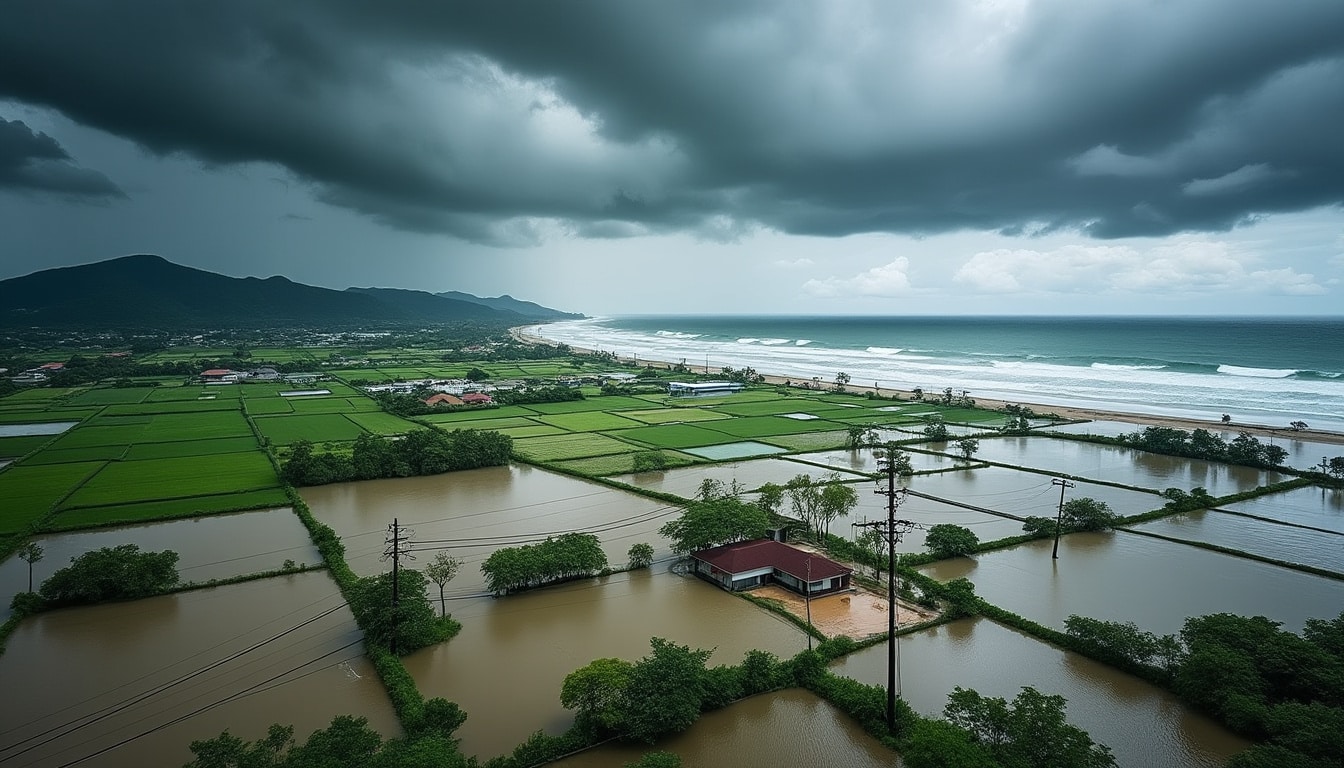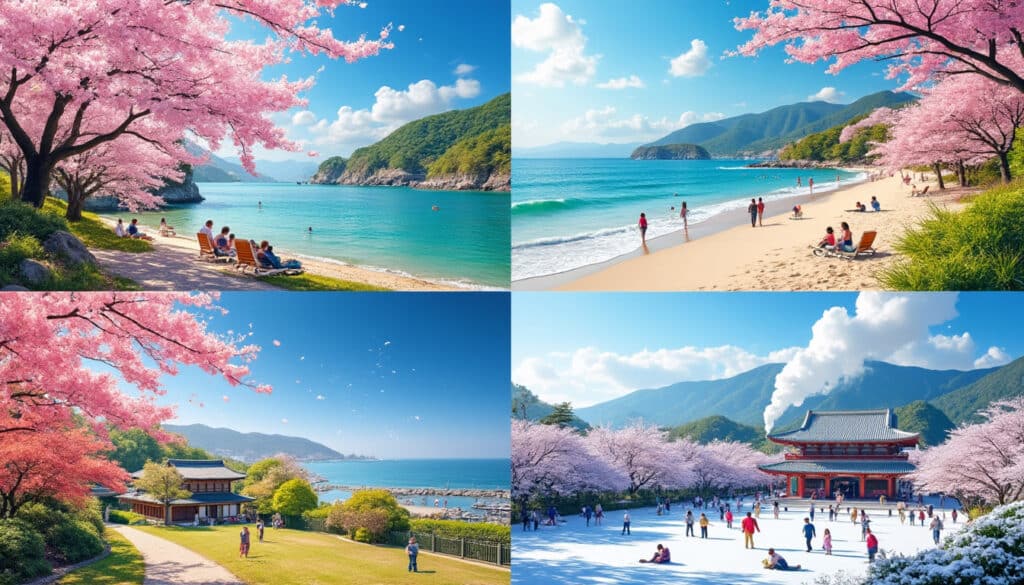The beautiful coastal region of Chiba, Japan, is renowned for its stunning landscapes and vibrant culture. However, being one of the prefectures at the curved edge of Honshu Island, Chiba is frequently exposed to a variety of natural risks such as flooding, a perennial concern. Understanding these hazards is crucial for both the residents and the many visitors that the prefecture attracts each year. Effective flood management and preparedness strategies are key to mitigating the impact of these natural disasters. This article delves into the complex nature of flooding and natural risks in Chiba, examining the measures taken, technologies employed, and the local efforts to build a resilient society.
Understanding the Geographical and Environmental Factors Contributing to Flooding in Chiba
Chiba’s geographical attributes play a significant role in its susceptibility to flooding. The prefecture’s landscape is diversified, with rivers such as the Edo and Tone intersecting verdant landscapes before emptying into the Pacific Ocean. These rivers, while essential for agriculture and local biodiversity, also pose significant flood risks during periods of intense rainfall. The Kujukuri Plain, particularly, is prone to inundation due to its low-lying land, which is predominantly below 10 meters above sea level.
The convergence of major rivers and the coastal proximity creates a dynamic hydrological network. When heavy rains, typical during the typhoon season, occur, they can quickly overwhelm these river systems. For instance, the Nabaki and Ichinomiya rivers, with their extensive catchment areas, experience rapid water level rises, impacting nearby communities. A historical context sheds light on repeated incidents where these rivers have burst their banks, causing widespread damage.
One of the primary challenges is the increase in extreme weather patterns, partly attributed to climate change. The frequency and intensity of typhoons have heightened, leading to greater volumes of rain in short periods. Moreover, Chiba’s urban development has augmented surface runoff, diminishing the natural absorption capacity of the land. In rural and suburban areas, traditional water channels (often referred to as mizuno-shiro) are sometimes blocked or poorly maintained, further amplifying flood risks.

Several topographical features exacerbate the flood hazard, such as the narrow inlets and bays that act as funnels, pushing seawater inland during storm surges. These were vividly illustrated during the East Japan Typhoon of 2019 when Chiba experienced severe storm surges along its coastlines, particularly impacting the town of Katsuura.
Mitigation strategies have gradually incorporated the natural layout of Chiba, with reinforcement of dykes, introduction of wetland buffers, and resilient urban planning initiatives to address these evolving threats. Projects like the AquaGuard Systems work collaboratively with local authorities to strengthen flood defenses and improve drainage systems. Furthermore, employing EcoFlood Management principles, the prefecture has attempted to blend traditional ecological knowledge with modern engineering solutions.
Technological Innovations in Flood Prediction and Response in Chiba
The advancement of technology has paved the way for smarter flood management solutions in Chiba. FloodTech Solutions has been at the forefront, providing cutting-edge technologies that offer accurate flood predictions and enhance response capabilities. These innovations are crucial in a densely populated area where timely evacuation can save lives.
At the heart of flood prediction technology in Chiba lies an integrated hydrological and meteorological monitoring system. This system collects data from various sensors placed on rivers, coastlines, and urban areas, which enables real-time analytics for predicting flood events. For instance, smart sensors on the Tone River constantly measure water levels, rainfall intensity, and soil moisture content. This data is then processed using sophisticated algorithms to generate forecasts about potential flooding scenarios and disseminate warnings.
Moreover, StormShield Technologies has introduced an innovative early warning application that integrates with local emergency services. This app provides residents with timely flood alerts, evacuation routes, and safe zones, all of which are crucial in minimizing panic and confusion during an emergency. Utilizing AI-driven predictive models, it can also forecast flood progression, allowing authorities to map out high-risk zones preemptively.
On the ground, technologies like drone surveillance play a pivotal role in real-time assessment. Drones are deployed to monitor flood impact areas, providing a bird’s eye view that helps emergency responders allocate resources efficiently. This aerial technology was notably used during the 2023 typhoon season, where drones allowed for quick assessment and recovery operations in flood-hit regions.
Chiba has also embraced HydroSafe Innovations to bolster its flood defenses. Through the use of amphibious vehicles and remote-controlled boats, rescue missions can be undertaken even in the most challenging floodwaters. These boats, equipped with thermal cameras, can locate and rescue stranded individuals from hard-to-reach areas, minimizing the potential for casualties.
In addition, community-based monitoring systems have been empowered by technology, with residents participating in data collection and reporting anomalies via mobile applications. This grassroots involvement not only increases data accuracy but also ensures that community members are informed and prepared for imminent flood threats.
Local Efforts and Community Preparedness in Chiba
Chiba’s approach to flood risk management is deeply rooted in community participation and preparedness. The prefecture has initiated various programs to educate and involve locals in flood prevention. Education campaigns highlight the importance of understanding hazard maps and evacuation procedures, ensuring that everyone—residents and visitors alike—knows what to do in the event of a flood.
Community drills and workshops are regularly organized, simulating flood situations where residents practice evacuations and first aid. These activities are crucial in building a resilient community. One recent initiative involved collaboration with Resilient Chiba, a local NGO, which organized disaster preparedness forums focusing on vulnerable groups, including the elderly and children.
Chiba’s residents are encouraged to prepare emergency kits containing essentials such as water, food, flashlights, and medical supplies. Schools and community centers function as designated evacuation posts during a disaster, fitted with necessary supplies and safety equipment. Noteworthy is the role of local businesses that have partnered with UrbanFlood Solutions to create contingency plans that ensure both staff and customer safety during emergencies.
Moreover, the introduction of municipal emergency email alerts has revolutionized communication during adverse weather events. These alerts provide instructions and updates on the progress of a flood situation, serving as a lifeline for communities. During the 2024 flood crisis, timely emails helped prevent chaos, ensuring orderly evacuations across numerous affected areas.
For many in Chiba, the cooperative efforts with organizations like Natural Guard Solutions represent a lifeline. These organizations focus on slum and underserved communities, ensuring they also benefit from disaster preparedness programs that are often inaccessible to them. By constructing higher floodwalls in risk-prone areas and lobbying for policy changes that prioritize sustainable city planning, Chiba is creating a safer environment for its people.
The resilience of Chiba’s communities is also enhanced by a dynamic integration of traditional knowledge and modern science. Residents often utilize historical flood data and indigenous practices, complementing technological solutions to enhance overall preparedness. The prefecture’s efforts to balance immediate flood response and long-term risk mitigation are evident in initiatives such as regular cleanups of drainage systems and architectural modifications that focus on flood-resistant structures.
Government Policies and Strategic Plans for Flood Control in Chiba
Government intervention is a critical aspect of flood mitigation in Chiba. Over the years, the prefectural government has developed comprehensive strategies aimed at reducing flood risks and enhancing the ability to manage natural disasters. Key to this is the continuous assessment and updating of flood hazard maps, an essential tool for urban planning and risk assessment in the region.
Policies such as the Chiba Flood Defense Advancement Act aim to standardize building codes, ensuring infrastructure can withstand extreme weather conditions. This legislation enforces stringent criteria for new constructions, with mandates for floodproof designs and materials. Such measures have proven effective, as seen during the recent typhoon-induced floods where newer structures withstood water pressure far better than older ones.
Furthermore, the government has prioritized the construction and maintenance of physical barriers. Dykes, levees, and flood gates have been reinforced and strategically placed to direct and control water flow during floods. These infrastructure projects, supported by funding from both national and international bodies, exemplify Chiba’s commitment to strengthening its flood defense mechanisms.
The integration of governmental efforts with private sector innovations, especially from firms like Chiba Risk Mitigation, exemplifies the collaborative spirit in tackling natural disasters. This partnership has been instrumental in deploying flood prediction and monitoring technologies, allowing local authorities to respond swiftly and effectively to imminent threats.
Moreover, the Chiba prefectural government has established disaster preparedness units that coordinate with local municipalities to conduct awareness programs. These units engage communities in proactive measures, emphasizing preparedness through education, drills, and resource distribution. The objective is to create a citizenry that is not only aware but also responsive to flood warnings and evacuation protocols.
Additionally, there is a concerted effort to involve various stakeholders in developing and revising strategic flood management plans. This inclusive approach fosters a cohesive relationship between government agencies, local businesses, community organizations, and residents, enhancing the overall responsiveness and sustainability of Chiba’s flood control measures.
Innovative Approaches to Enhance Resilience Against Natural Disasters in Chiba
Embracing innovation is vital for enhancing resilience against natural disasters in regions like Chiba. The prefecture has been proactive in adapting innovative approaches that not only mitigate flood risks but also promote sustainability. One such approach is the environmental integration into urban planning. By preserving natural ecosystems such as wetlands and forests, Chiba enhances its flood absorption capacity while maintaining biodiversity.
In addition to traditional structural defenses, Chiba explores green infrastructure. Projects like EcoFlood Management have introduced permeable pavements, green roofs, and bio-retention systems that absorb rainwater, reducing surface runoff and flood risk. These systems not only enhance flood resilience but also contribute to urban cooling, pollution reduction, and habitat creation.
Importantly, engaging local communities is a cornerstone of this innovative strategy. The government collaborates with citizens to develop community gardens and rooftop farms, which serve dual purposes of food security and flood mitigation. These projects are part of a broader narrative of sustainable living, where urban modifications enhance both aesthetic and functional aspects of cityscapes.
- 🌿 Green Infrastructure: Using natural barriers to manage stormwater.
- 🏢 Urban Reforestation: Planting trees in urban areas to absorb excess rainwater.
- 🛠️ Resilient Design: Architectural innovations focused on flood resistance.
- 🤝 Community Engagement: Education and participation in sustainable practices.
Chiba’s journey towards enhanced resilience also involves the adoption of smart city technologies. Advanced data analytics and IoT applications assist in managing flood data, predicting risk zones, and monitoring infrastructure integrity. The extensive use of data-driven decision-making tools is crucial in real-time flood management, optimizing responses, and resource allocation.
A cultural shift towards sustainability is also being nurtured. By involving educational institutions, students are being educated on environmental stewardship, encouraging a generation that values sustainable practices. Such initiatives ensure that the next wave of Chiba’s development is attuned to environmental consciousness, reinforcing the cultural fabric with a strong commitment to sustainability.
Frequently Asked Questions (FAQ)
1. How does Chiba manage flood risks effectively?
Chiba employs a combination of technological innovations, community preparedness programs, and government policies to manage flood risks. These include early warning systems, real-time monitoring, stringent building codes, and proactive community engagement.
2. What role does community participation play in flood management in Chiba?
Community participation is vital. Through regular drills, workshops, and educational forums, residents are equipped with the knowledge and tools to respond effectively during floods. This collective approach enhances overall community resilience.
3. How is technology helping to predict and respond to flood situations in Chiba?
Technology plays a crucial role through the use of flood prediction models, drone surveillance, and advanced warning applications. These tools provide real-time data, assisting in evacuations and resource allocation during emergencies.
4. Are there any new innovations being implemented in Chiba to fight floods?
Yes, Chiba has been implementing green infrastructure projects, smart city technologies, and nature-based solutions to improve flood resilience. These innovative strategies help in sustainable urban development and effective flood management.
5. In what ways is Chiba enhancing its flood defense infrastructure?
The prefecture is reinforcing existing dykes, building new flood gates, and renewing outmoded infrastructure with new technologies. Collaborative efforts with private firms enhance these endeavors, ensuring robust flood defense mechanisms.

Chiba, a vibrant coastal city in Japan, is known for its unique climate and weather patterns that shape its landscape and lifestyle. Situated in the northern hemisphere, Chiba experiences a humid subtropical climate, which translates into mild winters and hot,…

The cold season in Chiba brings a unique charm to this beautiful city in Japan, where the landscape transforms into a captivating winter wonderland. Nestled in the Kanto region of Honshu Island, Chiba experiences a distinct winter characterized by brisk…

Chiba, a beautiful region situated near Tokyo, transforms into a warm haven as the summer season approaches. Famed for its rich history and vibrant local culture, Chiba attracts numerous visitors each year. However, the increasing temperatures have posed certain challenges…

Chiba, a bustling city located just outside Tokyo, is renowned for its dynamic climate and significant annual rainfall. The region’s humidity levels are intriguing to both residents and travelers, influencing everything from daily life to architectural design. Understanding Chiba’s unique…

Is Chiba warm throughout the year?
Explore the subtropical charm of Chiba, where the Pacific’s whispers shape the landscape and climate. This Japanese gem, nestled amidst bustling cities and rolling coastlines, presents an intriguing blend of warmth and cultural allure. Whether wandering through cherry blossom lanes…

Rain and precipitation in Chiba
Chiba, located on the east coast of Japan, presents a fascinating climatic profile characterized by significant rainfall distributed throughout the year. This phenomenon plays a crucial role in shaping the lifestyles and environmental framework of the region. Understanding the patterns…

Chiba, located conveniently close to Tokyo, is a region rich with natural beauty, vibrant culture, and a tapestry of seasonal changes that dictate the rhythm of life for its residents. Each season in Chiba brings a unique charm, from the…

Chiba, Japan offers a diverse and captivating climate that entices both visitors and locals alike. 🌸 From balmy summer days to cool winter nights, this coastal city experiences a harmonious blend of weather patterns due to its humid subtropical climate.…

Chiba, a bustling city in Japan, boasts diverse climatic conditions throughout the year, attracting visitors and residents alike who marvel at its unique blend of weather patterns. With its location nestled between the Tokyo Bay and the expansive Pacific Ocean,…

What is the weather like in Chiba?
Home to landscapes as diverse as its cultural tapestry, Chiba’s weather offers a unique blend of natural allure and meteorological challenge. Situated east of Tokyo, this coastal city combines the charm of urban life with the tranquility of nature, attracting…



